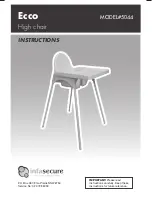
Figure 20.2
Figure 20.3
Figure 20.1
There are two types of profiles in the Cooldek range; Cooldek Classic
and Cooldek CGI, refer figure below. The same procedure is used
when fixing either option to the frame.
When attaching the Cooldek Sheeting, start from the rear on one
side of the gable. Lift the first sheet into place and slide firmly into
the angled back channel. Check the sheet is square against the
receiving channel and the beam capping and fix into position. Lay
the next sheet of decking over the previous sheets side lap and
ensure that the slip joint of the two sheets has engaged, refer figure
20.0 and 20.1.
Note:
The minimum Cooldek sheet length is 2.0m. If your design
requires sheets smaller than 2.0m they will be supplied at 2.0m and
require cutting on site.
Ridge End
Sheeting is fastened to the angled back channel using 4.8mm sealed
rivets to the underside of the sheeting at maximum 200mm centres
and 12 x 20 hex head self drilling screws with neoprene washer
from the top into each crest for the Classic profile and every third
crest for CGI, refer figure 20.2.
Beam Capping End - WITH A SIDE GUTTER
If a side gutter is being attached to the unit an ‘Angled Cutback
Flashing’ will need to be fixed to the ends of the sheeting. Cut back
the foam and the bottom skin of the insulted deck to the beam
capping, refer figure 20.3. Slide the angled cutback flashing between
the beam capping and the sheeting. Rivet the cutback flashing to the
top sheet at 1000mm centres and fix the decking through each crest
for Classic and every second crest for CGI into the beam capping
(and the flashing). If using 50mm Classic panels use 14x125mm
hex head self drilling screws (14 x 150mm for 75mm Classic panels,
14 x 110 for 50mm CGI panels and 14 x 125 for 75mm CGI panels)
refer figure 20.3.
Pre-drill the crests of the ribs to provide clean holes for the seating
of neoprene washers. Use cyclone caps and neoprene washers for
all crest fixing. Do not over tighten screws. Fix side laps with 12x20
hex head screws with neoprene washer at approximately 1000mm
centres. Silicone to waterproof all rivets.
Beam Capping End - WITHOUT A SIDE GUTTER
If no side gutter is being installed fix the decking through each crest
for Classic and every second crest for CGI into the beam capping. If
using 50mm Classic panels use 14x125mm hex head self drilling
screws (14 x 150mm for 75mm Classic panels, 14 x 110 for 50mm
CGI panels and 14 x 125 for 75mm CGI panels), refer figure 20.4.
Pre-drill the crests of the ribs to provide clean holes for the seating
of neoprene washers. Use cyclone caps and neoprene washers for all
crest fixings. Do not over tighten screws. Fix side laps with 12 x 20
hex head screws with neoprene washer at approx 1000mm centres.
When no side gutter is present a standard cutback flahsing will be
used to protect the foam. Cutback the foam and the bottom skin of
the insulated deck by 20mm. Position the cutback flashing as shown
in figure 20.5 and rivet to the panel at 500mm centres from both
sides. Silicone to waterproof all rivets.
FIXING THE PANELS
COOLDEK CLASSIC
COOLDEK CGI
beam capping
beam
slip joint
side lap
12 x 20 hex head
screw
angled cutback
flahsing
14 gauge hex head self drilling
screw with cyclonic cap and
neoprene washer.
rivet angled
cutback flashing
to top sheet of
panel
angled cutback flashing
sits flush with beam
capping. Foam and
bottom skin of sheeting
needs to be removed to
here.
beam capping
ridge beam
decking
receiving channel
rivet through receiving channel
into decking at 200mm centres.
12 x 20 hex head self drilling screw
with neoprene washer through
angled receiving channel
side lap
12 x 20 hex head screw
slip joint
CLASSIC
CGI
Figure 20.0


































